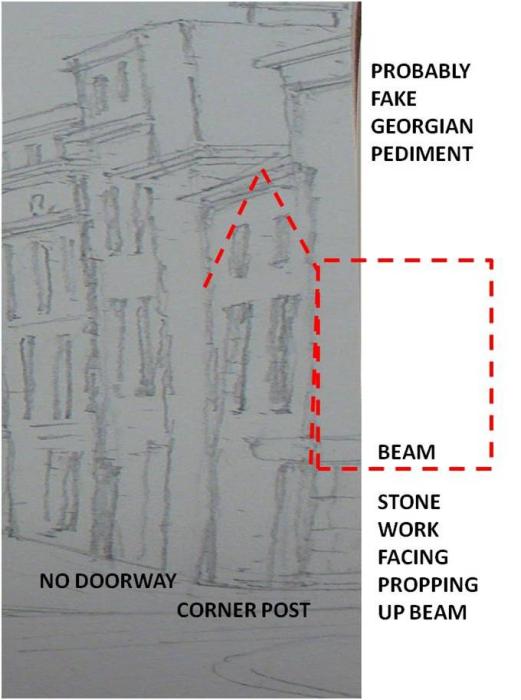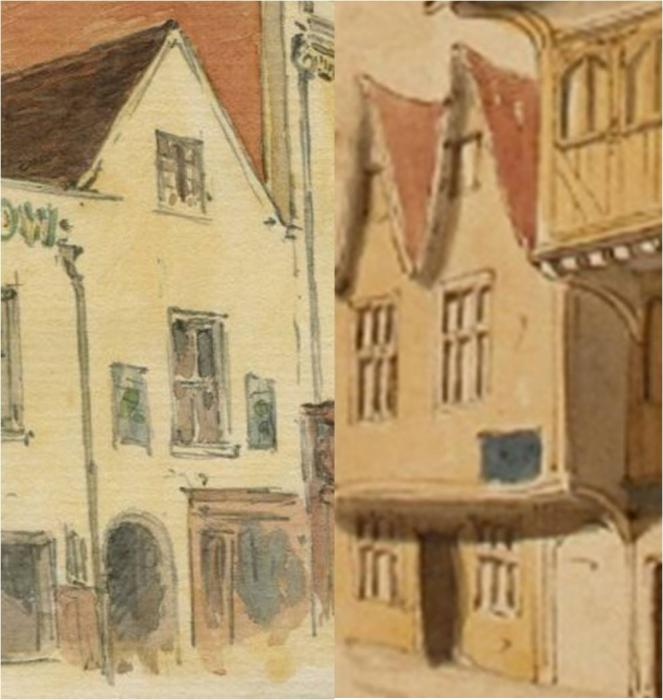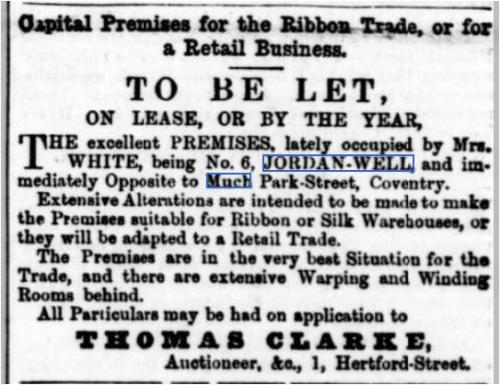|
Helen F
Warrington |
1 of 14
Tue 3rd Sep 2024 8:10pm
We come across odd bits about the pubs from time to time but they tend to get lost in the normal pub topic, so this is just for corrections or additions to the Cov Pub History resource.
|
| Local History and Heritage - Changes for the Cov Pub History | |
|
Helen F
Warrington Thread starter
|
2 of 14
Tue 3rd Sep 2024 8:48pm
Black Bear to the Coach and Horses at 128 plus rooms over the gateway and possibly also 129 Much Park Street.
Edward Waldron (of Alcester, Warwickshire, ironmonger) and John Catterns (of Coventry, tiler) owned Black Bear ?? - 1686
Thomas King 10 September 1686 bought Black Bear (occupied by Charles Millward) . Unknown when name changed.
Thomas King II died 1703
Thomas King III died <1748
Thomas King IV died <1748
Edward King brother to Thomas King IV sold Coach and Horses in 1748
William Lemon 23 March 1748 bought Coach and Horses (occupied by Turville Drayson) died 1759
Mrs Anne Lemon and son 17 Dec 1759 - 1768 inherited Coach and Horses
Cleophas Dullison 6 Nov 1768 - ?? bought the Coach and Horses. Although in the coaching/carting business I'm not sure that he ran them from here, but did use the White Bear (later the Craven Arms) on the High Street. May have bought the property for the stabling, coach houses and malt house. He died some time between 18 Nov 1775 and 1782 but I favour the early date due to a record in John Whittingham's diary.
Probably inhabited by Catherine Dullison and others till 1788 but money owed to carriage maker. Stopped being the inn some time between 1775 and 1781.
1 Nov 1788. executor of the will of Cleophas [II] Dullison (London surgeon) sold the properties to a weaver. Edward Inge attorney.
The Seven Stars/The Half Moon and Seven Stars to the Coach and Horses at 37 Much Park Street.
1777 John Hand proprietor of the 'old established' inn.
1778 The Seven Stars/The Half Moon and Seven Stars owned by Benjamin Lapworth bankrupt - Edward Inge the attorney who dealt with it.
1780 'lately' 7 stars
1781 now the Coach and Horses
The only link that I can find between the two locations of the pub was the Edward Inge who was the attorney for both properties. I can't say why the name was transferred other than it came available.
|
| Local History and Heritage - Changes for the Cov Pub History | |
|
Rob Orland
Historic Coventry |
3 of 14
Fri 13th Sep 2024 6:04pm
Well, this topic is working, thanks, Helen! I managed to find the link between the Half Moon and Seven Stars and the Coach and Horses in this sale notice in the Coventry Standard, 29th October 1781. It appears that even more old newspapers are being added to the BNA (or via FindMyPast, in my case) sites, and it's making pub research so much better. 
|
| Local History and Heritage - Changes for the Cov Pub History | |
|
Helen F
Warrington Thread starter
|
4 of 14
Fri 13th Sep 2024 7:19pm
Yes, I think that was the first time that the name was used at the new address. What I'm not sure is how long it was still used at the old one. Cleophas Dullison (I) bought it while it was still an inn from Anne Lemon but did he continue to run it as such or did it stop some time before he died? His son didn't run it as he was a surgeon in London but there was some provision for Catherine Dullison.
Advert from Monday 26 February 1776 in the Coventry Standard talks of post coaches going from the White Bear on the High Street. It also talks of the late Mr Dullison (so he did die in 1775) and that common stage waggons would go from his home on Much Park Street but it doesn't mention it as an Inn here. Catherine posts the advert.
I can't find an advert for the coach and horses that predates the transfer but I can find adverts for Dullison and his coach/waggon business. |
| Local History and Heritage - Changes for the Cov Pub History | |
|
Helen F
Warrington Thread starter
|
5 of 14
Fri 1st Nov 2024 11:07am
One of the earliest Coventry pubs is supposed to be the White Cellar which is variously recorded in different places Earl Street, Much Park Street, and Lower Park Street (tagged as Little Park Street but may not be). Most often it is located on Much Park Street. It could be on both Earl Street and Much Park Street if it was on the corner but since Jordan Well didn't always exist, it could have been east or west of the entrance to Much Park Street.
The last reference I can find is :-
BA/B/16/292/32
Date: 24 Feb 1498
Scope and Content: By Master John Bonde, master of Trinity Guild, and the fraternity to Anthony Harreson' (of Coventry, draper) of the White Cellar, Much Park Street (lately occupied by Edward Pell of Coventry, vintner) from 25 Mar 1498 for 12 years, rendering 40/- per annum; the guild will maintain the premises, not expelling without due cause the tenant, who is likewise bound, in 100 marks, to observe covenants.
This indicates that it belonged to the Trinity Guild and was no longer serving booze. There are some possible rentals after this that might be the same building but they're guesses. in 1485 135 of 387 properties belonging to Trinity Guild were empty, which might explain why there are no more direct references after Anthony. The Trinity Guild records of course come to a screeching halt in 1546 when it was dissolved by Henry VIII. Henry sold all the Guild's property on Earl Street and Much Park Street to John Hales. So the next step is to see if John Hales had any property on either corner of Much Park Street.
Of note, on the Bradford Map, the west corner of the end of Much Park Street was part of the Earl Street Ward but the east corner belonged to Much Park Street Ward and not Jordan Well.
There are no images of the west corner of Much Park Street because it was widened too early but Troughton captured this very limited view of the east side. This was a modified medieval building that had been modernised in the Georgian era. The lack of a door indicates that the property opened onto Much Park Street. While hard to interpret, the feature at the top of the building was probably a fake Georgian pediment. The main beam at the front is supported by stonework that probably wasn't original and may have been added from city wall demolition material. Bits and bobs of such stonework occurred all over the city. We do know from post war photography that the building that replaced this had a substantial basement, although there is no record of it having old materials.
 |
| Local History and Heritage - Changes for the Cov Pub History | |
|
Helen F
Warrington Thread starter
|
6 of 14
Fri 1st Nov 2024 12:55pm
The pictures below are successive modernisations of similar street front buildings with a gable. They were both a few doors east of the corner of Much Park Street. The first is part of the building just to the west of the Dun Cow. The window is not as tall as the Much Park Street version, suggesting it was modified in the 1800s, and not the 1700s. The second is a close neighbour or possibly an earlier incarnation of that. The jetty was retained and the windows look quite early in style. Modernisations varied and sometimes the jetty was boxed in, reducing the pavement and at other times the overhang was removed and the new brick face pushed back to the old property line. The first picture is about a 100 years later than the second.

|
| Local History and Heritage - Changes for the Cov Pub History | |
|
Slim
Another Coventry kid |
7 of 14
Sat 2nd Nov 2024 2:09pm
I read in this week's Money Week that since 2000, a quarter of pubs have closed. A sobering thought.
|
| Local History and Heritage - Changes for the Cov Pub History | |
|
Helen F
Warrington Thread starter
|
8 of 14
Sat 2nd Nov 2024 10:16pm
I don't know about closing, but pubs used to flit about like butterflies. While trying to find out more about the corner of Much Park Street and Jordan Well, I came across this snippet about the Warwick Arms from Coventry Standard - Friday 04 October 1861 that puts it on the corner. Now not only do the Pub Section records have it on the other side of the road, I know it was on the other side of the road because that sketch by Troughton I used above shows it on the north side of Jordan Well!  |
| Local History and Heritage - Changes for the Cov Pub History | |
|
Rob Orland
Historic Coventry |
9 of 14
Sun 3rd Nov 2024 10:06am
Oh, you make a great point there, Helen - that Warwick Arms gave me a right ol' runaround trying to establish it's true location! Here are some descriptions I found in the newspapers....
Sep 1850 - "Warwick Arms, Earl street" - nah!
Feb 1860 - "opposite the end of Much Park-street, being No. 6, Jordan Well" - correct!
Sep 1861 - "corner of Much Park Street, Jordan Well" - nope!
Sep 1862 & Feb 1863 - "Jordan Well" - better!
In the end we need to use census records and other things like the Goad Fire Insurance Plans to work out its true location. |
| Local History and Heritage - Changes for the Cov Pub History | |
|
Helen F
Warrington Thread starter
|
10 of 14
Sun 3rd Nov 2024 10:59am
This advert from Coventry Herald - Friday 24 February 1860, suggests that after Mrs White, the owners were going to rebuild. Maybe the Warwick Arms was homeless for a while and moved over the road? Much of this area was being modernised and that included the corner of Much Park Street, although I haven't worked out the date that happened, yet. I'm not even sure that the number 6 on the 1850 map was the same number 6 on the 1897 Fire Insurance maps. The building on the corner of Bayley Lane looks like a single property in 1850 but two in 1897.
 If you count along the road to the Mattock and Spade at number 16, you see that number 6 is one building further east than the later maps suggest. In Dr Troughton's sketch, that property marked with a star was out of sight. The one to the left is a tall, white painted building that is there in later photos. The sign for the Warwick Arms was on the join between the two.
If you count along the road to the Mattock and Spade at number 16, you see that number 6 is one building further east than the later maps suggest. In Dr Troughton's sketch, that property marked with a star was out of sight. The one to the left is a tall, white painted building that is there in later photos. The sign for the Warwick Arms was on the join between the two.  The yard at the back of the one with the star, looks more like it was suitable for extensive warehousing, warping and winding.
The yard at the back of the one with the star, looks more like it was suitable for extensive warehousing, warping and winding. |
| Local History and Heritage - Changes for the Cov Pub History | |
|
Rob Orland
Historic Coventry |
11 of 14
Mon 4th Nov 2024 10:12am
Yes, even after the research (albeit not as thorough as you have, Helen, with those super pictures), I still wasn't totally convinced that I had the exact spot for it - but at least we can give visitors to the site some idea of its location. Like you say, sometimes two properties joined into one, or even vice-versa, so always makes numbering (and sometimes, also, street renumbering!) problematic. All good fun though. |
| Local History and Heritage - Changes for the Cov Pub History | |
|
Helen F
Warrington Thread starter
|
12 of 14
Tue 19th Nov 2024 9:25pm
To return to the White Cellar. Part of the problem of locating it is the number of places it is recorded as being. Earl Street, Lower Park Street (Little Park Street), Much Park Street and even Gosford Street. I think that I've resolved most of those. The easiest is Lower Park Street (Little Park Street). This is a misinterpretation made for obvious reasons but wrong. Lower Park Street is a physical reference, the lower of the two Park Streets ie Much Park Street. Elsewhere Upper Park Street is correctly identified as Little Park Street. So we can reasonably say that Much Park Street featured. From the other references the west side connecting to Earl Street has been the favoured spot but I had an open mind about which side because of the confusion between where Earl Street, Jordan Well and Gosford Streets started and stopped. Confusion in large part because they weren't fixed. Jordan Well didn't even exist until 1421, before most of the records were written. At various times the junction with Earl Street and Gosford Street was either side of Much Park Street. So the White Cellar could have been on the east corner of Much Park Street.
Nothing I've tried pin points the White Cellar itself but I wondered if the neighbours might help... no, not my neighbours. I realised that the properties on the east side of the road butt up to what was once the Red Ditch. Many of the papers referring to them mention their eastern boundary. So I've collected the following.
Reference: PA2557/1/4/3
Date: 2 Mar 1482
J. Ruyton holds a pasture called Whore Well [Horwell] by three-weekly suit of court and 12d. per annum; he holds the house called the White Cellar
Thomas Ruyton was the son of John Ruyton.
Reference: BA/D/8/20/1
Date: 15 Mar 1491
Whereby Elizabeth, lately wife of Richard Kirkeby (of Atherstone [,Warwickshire], chapman) appoints Richard Lokeare of Coventry to receive for her life from Thomas Bradmedowe (of Coventry, draper and hosier) and John Lewes senior (chaplain) seisin in two Much Park Street messuages, lying between a tenement now Richard Braytoft's (lately William Corby's) and that belonging to Thomas Ruyton's heirs (formerly William Whitchirche's), being the nearer 32 feet from the White Cellar to the land once held by Peter de Eysesfeld', 26 feet deep from the street,
Reference: BA/B/16/299/8
Date: 6 Dec 1410
By Thomas de Meryngton' and his wife Margery to Robert Shypley (of Coventry, merchant), William Shypley (clerk) and Roger Benet of Coventry of a Much Park Street messuage lying between a tenement belonging to John the son of Richard Clerk (of Coventry, merchant) and that once the mercer William Corby's, extending from the highway to the red ditch,
Reference: BA/B/16/387/1
Date: 4 Aug 1435
From William Shipley (clerk), Richard Boton[er], William Radclyff and John Bryghtmer of Coventry to John Whalley, Roger Willenhale and John Neell of Coventry for (a) a Much Park Street messuage lying between the tenement of John the son of Richard Clerk of Coventry and that formerly belonging to the mercer William Corby, extending from the highway to the red ditch;
Earlier
Reference: BA/B/16/138/1
Date: 1270 - 1279
From John son of Adam the Clerk of Coventry to Thomas de Fakenham for (a) an Earl Street tenement called White Cellar, with solar, lying between land which Walter Bacun once held and Earl Street, and between Thomas' land and Lower Park Street; also (b) 5/- per annum rent which Thomas used to pay from his inner cellar and from the Lower Park Street land lying between (a) and W. Bacun's land:
Reference: BA/B/16/138/2
Date: 1277 - 1283
From John son of Alan the Clerk of Coventry to Henry Baker of Coventry for 10/- per annum rent from the White Cellar, Earl Street and the rent which he used to receive from Thomas de Fakenham of Coventry, which cellar lies between "Park Street" and the land which Alexander de Glovernia held,
None of this is set in concrete but I think that there are more links between Much Park Street neighbours of the White Cellar and the Red Ditch. |
| Local History and Heritage - Changes for the Cov Pub History | |
|
Rob Orland
Historic Coventry |
13 of 14
Tue 19th Nov 2024 9:54pm
Oh my word, Helen - being able to only give you one "thumbs up" doesn't come close to portraying my admiration for the quality of this research! |
| Local History and Heritage - Changes for the Cov Pub History | |
|
Helen F
Warrington Thread starter
|
14 of 14
Tue 19th Nov 2024 10:09pm
|
| Local History and Heritage - Changes for the Cov Pub History | |
Website & counter by Rob Orland © 2025
Load time: 620ms